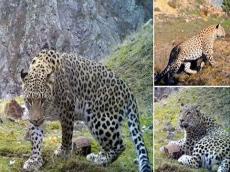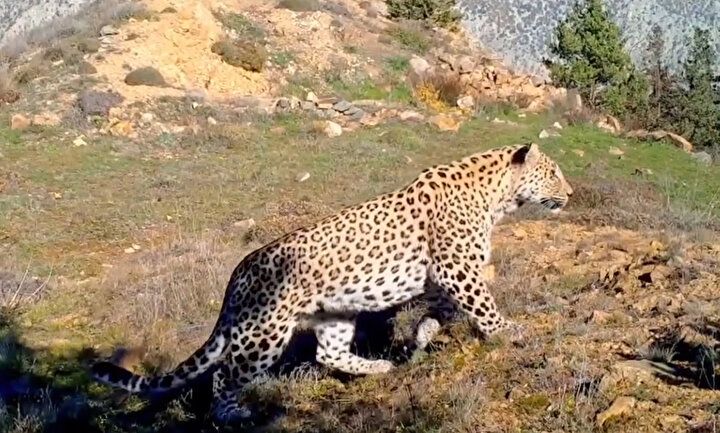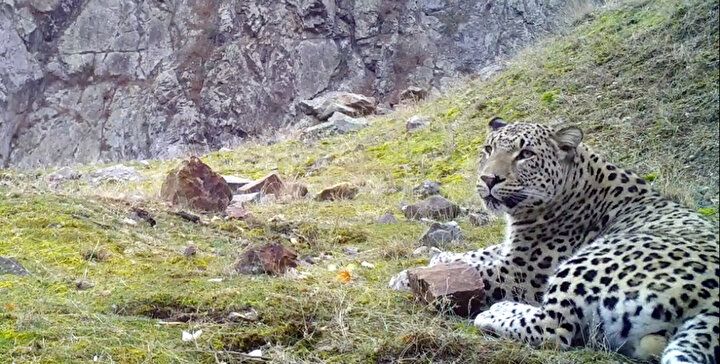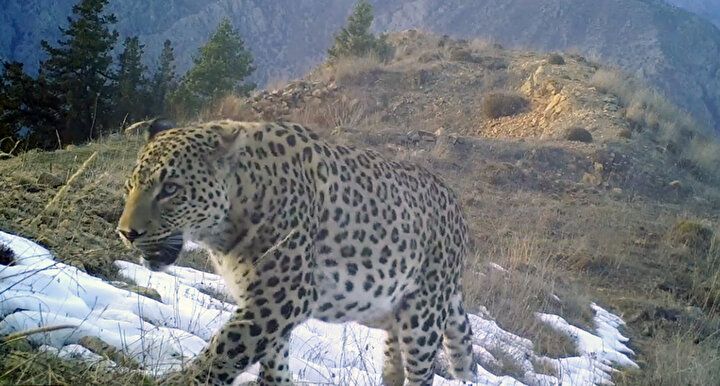|
|
TODAY.AZ / World news
Anatolian Parsi's DNA was obtained: it enters World Gene Bank
18 May 2023 [17:07] - TODAY.AZ

By News Center
The DNA data obtained in the laboratory from the urine sample made in front of a camera trap in 2020 by the Anatolian leopard, which was seen on August 8, 2019, when it was thought to be extinct, was recorded in the World Gene Bank as the 'Anatolian Leopard'.
A DNA sample was also taken after the Anatolian leopard, which is named 'leopard' in the world and 'pars' due to its use in Anatolian history, and is one of the eight subspecies of leopards all over the world according to scientific studies, was imaged for the first time in the Western Mediterranean. The research, which draws attention to the importance of the history and culture of the leopard, which is the most important terrestrial predatory mammal of Anatolia, is characterized as a historical turning point in terms of revealing the evidence for the existence of the Anatolian leopard.

First recorded 2 years ago
The Anatolian Leopard was photographed in the Western Mediterranean on August 8, 2019, by the teams of the 6th Regional Directorate of the General Directorate of Nature Conservation and National Parks (DKMP). After this screening, a TUB?TAK supported project was initiated in cooperation with the 6th Regional Directorate of DKMP and Isparta University of Applied Sciences (ISUBU). Within the scope of the project, 58 images of 2 Anatolian leopards in the Western Mediterranean have been obtained so far.
Its first official record was an international article
ISUBU Wildlife Ecology and Management Dr. Yasin Unal, DKMP 6th Regional Directorate Hasan Uysal, Dr. Ahmet Koca, De. Mevlut Zenbilci and Dr.Mustafa Önder Ersin from WWF-Turkiye prepared an article. With the article published in the international applied ecology and environmental research journal, the Anatolian leopard entered the world literature.

DNA extracted from a urine sample
Stating that the Anatolian leopard is accepted as a very valuable species both culturally and biologically in the world, Yasin Unal said that they have published an article that scientifically proves the existence of the Anatolian leopard, which is thought to be extinct, in Anatolia. Explaining that scientific studies are continuing after this article, Dr. Professor Unal stated that after it was determined that an Anatolian leopard released urine while it was showing in front of the camera, a swap sample was taken from its urine by DKMP experts, and this sample was sent to Sivas Cumhuriyet University.
Entered the world gene bank records
Explaining that the genetic data obtained after the laboratory examination was compared with other leopard species in the world and DNA data were obtained showing that this species is the Anatolian Leopard, Unal said, “With the DNA data, it entered the World Gene Bank records as 'Anatolian Leopard'. We continue to work on a new article about the genetic data obtained, its interaction with humans and wild animals, and other information such as where it roams its nutrition."

Other data also compared
In the article, it was also stated that the estimated criteria and features obtained from the images of the identified individual and the anatomical features of the Anatolian leopard were compared, and it was noted that it was determined that the shoulder height, feathers and body length, head size and head-to-body ratio and coat color were quite similar. In light of these data, it is stated in the article that the genetic material of the individual was collected from the field and analyzed by matching with the data of the World Gene Bank. The data obtained from the genetic study are being prepared for future publication.
On the IUCN's red list
In the article on the Anatolian leopard, which is shown as Vulnerable (VU) worldwide and as Critically Endangered (CR) on the Mediterranean scale in the International Union for Conservation of Nature (IUCN) Red List, it has been stated that it was distributed in forests in the Central Anatolia, Mediterranean and Aegean regions until 1975, and since then scientific research, it was reported that live recordings were not available except for unconfirmed information from people, locals, and hunters. In this study, it was stated that for the first time in history, a living individual (individuals) of the Anatolian leopard was photographed and video recorded in the Western Taurus Mountains of the Mediterranean Region of Turkiye, using the camera trap method.

Largest leopard subspecies
In the article, which also points out that their numbers are rapidly decreasing due to various death factors caused by human activities such as industrialization, forest fires, tourism, and poaching, the characteristics of the Anatolian leopard are listed as follows, according to the information obtained from previous scientific studies:
“The Anatolian leopard is the largest leopard subspecies. An adult male can weigh 100 kilograms, a total body length of 2.5 meters, and a tail of 80 centimeters. It has glossy, tawny, rather short-haired fur, a large rosette with fine edges, and a long, shaggy tail. It has a distinctive golden color although its body color is paler than that of the subspecies in India and Africa. The length of body hair varies between 1.5 and 2 cm on average.”
Used in gladiatorial battles in Rome
In the article, information about the use of the Anatolian leopard in gladiatorial wars in the Roman period is given as follows:
"When the Roman statesman Marcus Tullius Cicero was serving as the Governor of Cilicia between 51-50 BC, he requested that Anatolian leopards be sent from the Kibyratis region, which is located between the provinces of Antalya, Burdur, and Denizli in Turkiye today, to be used in gladiator wars. While classifying the leopard species based on the notes of Leopard on the characteristics of the leopard, they named the inhabitants of Anatolia 'Tulliana', inspired by Tullius, the forename of Cicero. The information about the Anatolian leopard dates back to ancient times. The oldest indication of the existence of leopards in Anatolia is "The wall reliefs in the Leopard Temple in Konya Çatalhoyuk, dating back 9,000 years. Many architectural works, sculpture finds, ceramics, and coins throughout history show the importance of the Anatolian leopard in almost every period of Anatolian history."
URL: http://www.today.az/news/regions/235067.html
 Print version
Print version
Connect with us. Get latest news and updates.
See Also
- 10 May 2025 [23:23]
US Secretary of State Marco Rubio holds telephone conversation with Pakistani Leadership - 10 May 2025 [22:27]
Trump signals potential 80% tariff on China ahead of trade talks - 10 May 2025 [21:21]
Algeria accelerates efforts to eliminate French from official use - 10 May 2025 [20:31]
Azur Air Flight to Antalya returns to Mineralnye Vody due to technical malfunction - 10 May 2025 [18:31]
Pakistan's Prime Minister Shehbaz Sharif Chairs National Command Authority Meeting - 10 May 2025 [14:22]
European leaders visit Kyiv for high-level talks with President Zelensky - 10 May 2025 [09:47]
President Ilham Aliyev shares footage on 102nd anniversary of National Leader Heydar Aliyev’s birth - 10 May 2025 [08:30]
France, Poland pledge joint defense initiatives under new strategic agreement - 08 May 2025 [23:30]
Scientists discover new species of ancient sharks swimming off coast of Britain - 08 May 2025 [22:55]
Türkiye enters new space era with domestic satellite Türksat 6A
Most Popular
 President Ilham Aliyev meets with residents who moved to Kangarli village in Aghdam and presented them with keys to their new homes
President Ilham Aliyev meets with residents who moved to Kangarli village in Aghdam and presented them with keys to their new homes
 Ministry of Defense Leadership pays tribute at Alley of Honor
Ministry of Defense Leadership pays tribute at Alley of Honor
 President Ilham Aliyev shares footage on 102nd anniversary of National Leader Heydar Aliyev’s birth
President Ilham Aliyev shares footage on 102nd anniversary of National Leader Heydar Aliyev’s birth
 Azerbaijan and Morocco strengthen employment ties with new cooperation plan
Azerbaijan and Morocco strengthen employment ties with new cooperation plan
 Azur Air Flight to Antalya returns to Mineralnye Vody due to technical malfunction
Azur Air Flight to Antalya returns to Mineralnye Vody due to technical malfunction
 Azerbaijan's Ministry of Defense provides housing to military personnel as part of Social Protection Program
Azerbaijan's Ministry of Defense provides housing to military personnel as part of Social Protection Program
 Heydar Aliyev's leadership laid foundations for Azerbaijan's sovereignty and future development
Heydar Aliyev's leadership laid foundations for Azerbaijan's sovereignty and future development
